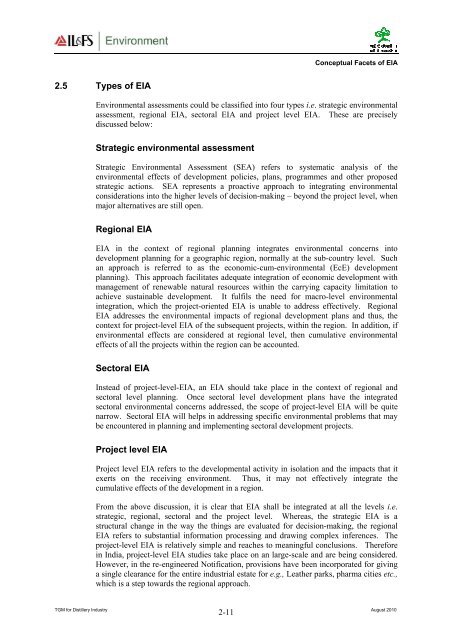Distillieries - Environmental Clearance
Distillieries - Environmental Clearance
Distillieries - Environmental Clearance
You also want an ePaper? Increase the reach of your titles
YUMPU automatically turns print PDFs into web optimized ePapers that Google loves.
Conceptual Facets of EIA2.5 Types of EIA<strong>Environmental</strong> assessments could be classified into four types i.e. strategic environmentalassessment, regional EIA, sectoral EIA and project level EIA. These are preciselydiscussed below:Strategic environmental assessmentStrategic <strong>Environmental</strong> Assessment (SEA) refers to systematic analysis of theenvironmental effects of development policies, plans, programmes and other proposedstrategic actions. SEA represents a proactive approach to integrating environmentalconsiderations into the higher levels of decision-making – beyond the project level, whenmajor alternatives are still open.Regional EIAEIA in the context of regional planning integrates environmental concerns intodevelopment planning for a geographic region, normally at the sub-country level. Suchan approach is referred to as the economic-cum-environmental (EcE) developmentplanning). This approach facilitates adequate integration of economic development withmanagement of renewable natural resources within the carrying capacity limitation toachieve sustainable development. It fulfils the need for macro-level environmentalintegration, which the project-oriented EIA is unable to address effectively. RegionalEIA addresses the environmental impacts of regional development plans and thus, thecontext for project-level EIA of the subsequent projects, within the region. In addition, ifenvironmental effects are considered at regional level, then cumulative environmentaleffects of all the projects within the region can be accounted.Sectoral EIAInstead of project-level-EIA, an EIA should take place in the context of regional andsectoral level planning. Once sectoral level development plans have the integratedsectoral environmental concerns addressed, the scope of project-level EIA will be quitenarrow. Sectoral EIA will helps in addressing specific environmental problems that maybe encountered in planning and implementing sectoral development projects.Project level EIAProject level EIA refers to the developmental activity in isolation and the impacts that itexerts on the receiving environment. Thus, it may not effectively integrate thecumulative effects of the development in a region.From the above discussion, it is clear that EIA shall be integrated at all the levels i.e.strategic, regional, sectoral and the project level. Whereas, the strategic EIA is astructural change in the way the things are evaluated for decision-making, the regionalEIA refers to substantial information processing and drawing complex inferences. Theproject-level EIA is relatively simple and reaches to meaningful conclusions. Thereforein India, project-level EIA studies take place on an large-scale and are being considered.However, in the re-engineered Notification, provisions have been incorporated for givinga single clearance for the entire industrial estate for e.g., Leather parks, pharma cities etc.,which is a step towards the regional approach.TGM for Distillery Industry August 20102-11

















